
Part clamping devices are an inseparable part of a CNC workshop. As CNC machining has evolved over the years and parts have become more complex, a lot of research has also been done on the design of CNC fixtures. However, they are not discussed in as much detail as other developments, although their role in precise part positioning and machining accuracy is undeniable.
In this article, we look at the topic of CNC jigs and discuss several innovative types of CNC jigs.
Types of CNC accessories
Let's dive right into the topic. There are many types of machining accessories, depending on the part, the machine and the machinist. The following sections on types of CNC fixtures aim to cover the main types found in a machinist's fixture toolbox.

CNC lathe device
CNC vises are the preferred machining device for most machining setups due to their versatility and ease of use. They are derived from the traditional lathe, popular in woodworking and handcrafting, and represent the most accurate version of it.
CNC vises provide incredible clamping force through a hydraulic/pneumatic screw mechanism. Its internal mechanism consists of two inclined surfaces (like a wedge) pressed against each other to increase rigidity and prevent lifting of the jaws.
Furthermore, they also feature flat, precise edges on their outer perimeter. These surfaces are perpendicular to each other, allowing the vise to be precisely positioned on the worktable or custom fixtures.
Another characteristic is the construction of the jaw. Although they appear flat, the surface texture and clamping force create high clamping pressure that maintains a firm grip on the part during machining.
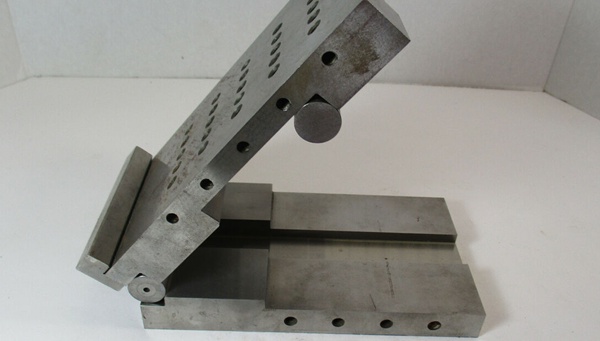
Angular device
Angle jigs are another commonly used tool among CNC parts accessories. Its main objective is to hold the piece at certain angles. The most common applications include chamfering, chamfering and angle drilling.
Just like CNC lathe, angle devices are reliable and stable. The angle plate usually has a hole pattern for convenient placement and assembly of parts. Additionally, many products also feature an adjustable angle with a locking mechanism so machinists can adjust it to suit their needs.
Angle jigs are extremely useful for machinists working with parts that are beyond the capabilities of their machine. For example, a prismatic part with some angled surfaces can be easily machined on a 3-axis machine with an angle fixture. At the same time, it can also be processed on a 4-axis machine, although at an additional cost.
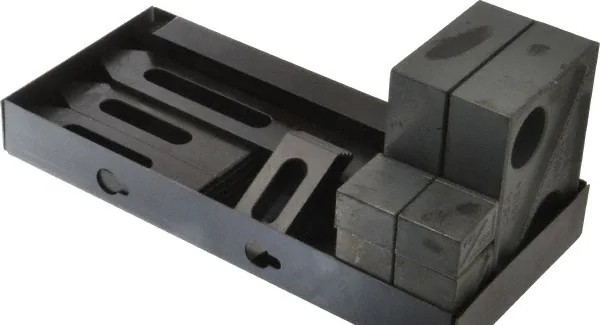
Clamping device
Clamps come in many different types and shapes, but the basic purpose remains the same. They hold the part in place by applying mechanical force. This force is often exerted by screws or springs. Some popular types of clamps include step clamps, edge clamps, clamp clamps, and edge clamps.
While clamps are not necessarily a CNC device per se, they fall into the broad category. Therefore, they are worth mentioning here.
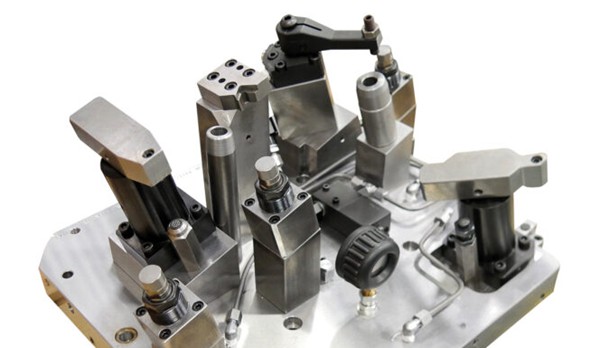
Tension device
Jigs are important machining devices used to guide the movement of the cutting tool and position it precisely over the workpiece. A common application of jigs is drilling. If a part has multiple holes in different locations, using a template with pre-drilled holes (like a template) saves a lot of time.
There are different types of devices:
- plate meter
- Model theory
- angle meter
- Sheet device
- diameter gauge
It is important to note that many engineers differentiate between jigs and fixtures due to the specific function of the fixtures that control the movement of the tool. Holders, on the other hand, are strictly speaking devices that hold and position the workpiece. Despite this distinction, jigs and fixtures fall into the broad category of part clamping and often operate side by side.
Indexing Device
Indexing devices are extremely useful in producing parts with evenly spaced geometric patterns. For example, a circular part with a hole every 30 degrees. Common applications include cutting slots, gears, and milling slots, all of which are evenly spaced geometric features.
The CNC dividing heads are robust and can be easily attached to the work table. Furthermore, modern CNC dividing heads with servo controls can be automated and controlled directly from the machine controller or an independent control unit.
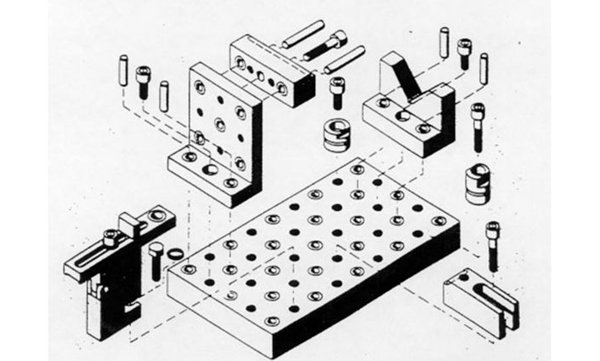
Modular device
Modular fixtures are one of the most innovative types of CNC fixtures on this list. They are not part of a standard clamping system and geometry like vices and clamps. Instead, they consist of a wide range of interchangeable components that can be assembled into a custom fixture assembly unique to the task at hand.
These reconfigurable components include plates, clamps, brackets and positioners in a variety of sizes. Furthermore, its assembly is quick and easy and is carried out using positioners or fasteners.
Modular devices offer numerous advantages. Because they are adaptable to different applications, they save costs by investing less in specialized accessories. Additionally, they are accurate tracking devices and can be expanded to larger structures.
CNC fixture design considerations
Designing CNC fixtures can be quite a complex process. Depending on the part design and machine functions, the difficulty of the process may vary. We give you some expert tips to make the CNC part fixture design process more manageable and systematic.
1. Clearly define the design requirements of your CNC device
As with any engineering project, CNC fixture design begins with defining the problem. In this context, designers must clarify their objectives in terms of production accuracy, cost, scheduling, etc., to obtain a clear picture of what they want.

2. Collect relevant store information
The next step is to collect information about your resources. This includes the type of CNC machine you have, the materials your equipment will work with, the number of machining operations and their sequence, and, of course, the part specifications.
3. Develop more than one project for CNC fixture design
The advantage of CNC part clamping devices is that there is never just one solution. You can be creative in the design of accessories and develop different solutions for fixing parts. As a designer, it is advisable to gather all the ideas and prepare a basic sketch of each idea for comparison.
4. Choose the best CNC fixture idea
Once you have several ideas on the table, the next step is to weigh the pros and cons in light of your project's specific needs. Eventually, after some consideration, you will decide which option is best for your application. Remember to consider everything, including manufacturing costs, tooling costs, maintenance, and product lifespan.
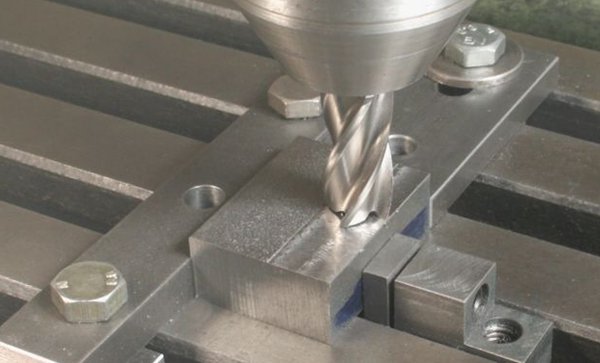
5. Optimize and implement the selected CNC device
The final step is to optimize the chosen design and finalize production plans. The goal is to maximize device accuracy and cost-effectiveness. Experts advise using standard components such as clamps, screws, plates, etc. if possible to benefit from their quality and low cost.
Another recommendation is not to focus too much on the finish as it is just a template. Use expensive surface finishing methods only if absolutely necessary.
Also, the last tip is a bit counterintuitive but useful. Very tight part tolerances should also be avoided. They do not necessarily improve positioning accuracy, but they do increase costs. Typically, machinists can easily eliminate small inaccuracies in the configuration and positioning of parts.
Advanced CNC clamping techniques for machined parts
The field of CNC fixture design is evolving as quickly as machining technology itself. With the advent of Industry 4.0, CNC accessories for parts have evolved into smart devices. In the following sections we will discuss some of these developments.
1. Robotic Device Charging
Loading and unloading processing equipment has always been time-consuming. Modern machine shops now save a lot of time by loading and unloading equipment using robots. This is not only fast, but also much more accurate than manual loading.
Additionally, robotic arms can store hundreds of routines, allowing production engineers to automate the loading and unloading of their entire fleet of products with just one robot.
2. CNC Device Monitoring
Process and configuration monitoring by CNC device is also an interesting application of modern technologies in this area. Some fixture designers use sensor measurements at various locations on the fixture to monitor things like clamping force, validating parts, and confirming fixture position.
3. Device Damping
Damping is an important factor in suppressing machining vibrations, which can have catastrophic consequences for the part when problems such as vibration occur. Certain types of CNC fixtures utilize special damping materials that can absorb machining forces while keeping the part stable and well positioned. This is a great solution to avoid problems like chatter.
Do I need a custom CNC fixture?

In the previous sections, we talked about various types of CNC accessories. However, despite the many machining accessories available on the market, it is not always possible to hold and position certain parts with standard clamping solutions.
In this case, you should consider a custom CNC fixture. As the name suggests, this is a device tailor-made for a specific application.
Technically speaking, it's easy to decide whether or not you need a custom accessory. When standard solutions aren't enough, you need them. However, you must also consider factors such as the cost of designing and manufacturing custom CNC fixtures and the return on investment. It's more of a business decision than a technical one.
Concluding
CNC fixtures are undoubtedly a crucial element of the machining industry and play a crucial role in maintaining quality standards. With various types of CNC accessories, this is also a diverse field in engineering projects.

Common questions
What kind of parts can CNC accessories support?
CNC fixtures are flexible devices that can contain round, prismatic, plate, cylindrical and irregularly shaped parts.
Are CNC accessories interchangeable between different CNC machines?
Most CNC fixtures are interchangeable due to their standard geometric characteristics. However, in rare cases this may not be possible if the machine specifications differ significantly or if the device is custom-made.
How do I choose the right CNC accessory for my application?
Several factors must be taken into consideration, such as dimensions, shape and material of the part, machining operations, sequence of these operations and capabilities of the CNC machine.

























































